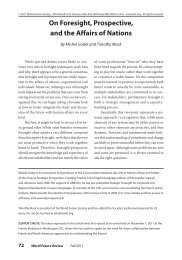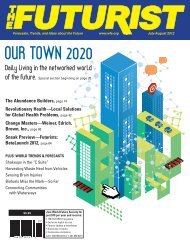Trends Shaping Tomorrow's - World Future Society
Trends Shaping Tomorrow's - World Future Society
Trends Shaping Tomorrow's - World Future Society
You also want an ePaper? Increase the reach of your titles
YUMPU automatically turns print PDFs into web optimized ePapers that Google loves.
4.5% of revenues. Corporate R&D in<br />
the United States has shifted in recent<br />
years, with less emphasis on<br />
pharmaceuticals and computer-related<br />
fields and more focus on biotechnology,<br />
nanotechnology, and security<br />
technologies.<br />
• China has taken second place in<br />
the world’s R&D spending, with a<br />
budget estimated at $136 billion in<br />
2006, up from $60 billion in 2001.<br />
Still more spending may be hidden<br />
in military budgets. China says it<br />
will raise its R&D spending from<br />
about 1.23% of GDP in 2004 to 2.5%<br />
in 2020. In 2008, it spent 40% more<br />
on R&D than the year before. China’s<br />
output of research papers increased<br />
from just over 20,000 in 1998 to<br />
nearly 112,000 in 2008. It passed<br />
Japan, Germany, and the United<br />
Kingdom in 2006. A study by the European<br />
Union predicts that China<br />
and India will lead the world in R&D<br />
by 2025.<br />
• R&D outlays in Japan have risen<br />
almost continuously, to nearly 3.5%<br />
of GDP. In 2007, Japan spent about<br />
$148 billion on R&D. In 2008, its<br />
R&D spending grew by 4.4%.<br />
• R&D spending by the top 350<br />
companies in the European Union<br />
amounted to $170 billion in 2008, up<br />
8.1% in a year.<br />
• In Russia, government R&D<br />
funding amounted to about $53 billion<br />
in 2008, approximately 60% of<br />
total research funding in the country.<br />
Some 44% of Russia’s R&D budget<br />
goes to defense research, 10% to<br />
space. These figures omit whatever<br />
clandestine military research escapes<br />
notice. Owing to the global recession,<br />
however, Russia’s research budget<br />
faced planned cuts of 30% in 2009.<br />
• Western corporations are outsourcing<br />
a growing fraction of their<br />
R&D to foreign contractors, just as<br />
they do other functions. Much of this<br />
work goes to India, some to Russia<br />
and eastern Europe, but the growth<br />
area is China.<br />
Assessment and Implications:<br />
This is a significant factor in the acceleration<br />
of technological change.<br />
The demand for scientists, engineers,<br />
and technicians will continue<br />
to grow, particularly in fields where<br />
research promises an immediate<br />
business payoff.<br />
Low-wage countries such as China<br />
38 THE FUTURIST May-June 2010<br />
once took only low-wage jobs from<br />
advanced industrialized countries.<br />
Today, higher-paid jobs in science,<br />
technology, and the professions also<br />
are at risk.<br />
Countries like India, China, and<br />
Russia once suffered a brain drain as<br />
those with high-tech skills emigrated<br />
to high-demand, high-wage destinations.<br />
Today, many students and professionals<br />
spend time in the West to<br />
learn cutting-edge skills, and then return<br />
to their native lands to work,<br />
start companies, and teach. This promotes<br />
the growth of some developing<br />
countries while reducing the<br />
competitive advantages of the developed<br />
world.<br />
■<br />
Services are growing faster<br />
than any other sector of the<br />
global economy.<br />
• Service jobs have replaced many<br />
of the well-paid positions lost in<br />
manufacturing, transportation, and<br />
agriculture. These new jobs, often<br />
part time, pay half the wages of<br />
manufacturing jobs. On the other<br />
hand, computer-related service jobs<br />
pay much more than the minimum<br />
for workers with sound education<br />
and training. Medicine, the law, and<br />
many other well-paid occupations<br />
also fall into the service sector.<br />
• Service industries provide more<br />
than 79% of the GDP in the United<br />
States, 77% in France, 74% in Britain,<br />
73% in Japan, and 70% in Germany.<br />
In each case, services are growing<br />
rapidly; other sectors, less so.<br />
• Service industries account for<br />
about 77% of private nonfarm employment<br />
in the United States, up<br />
from 70% in 1990. Services accounted<br />
for the entire net gain in U.S. private<br />
employment in the decade ending<br />
2010.<br />
• In Britain, services provide<br />
80.4% of jobs; in France, 72%; in<br />
Japan, 68%; in Germany, 64%. In each<br />
case, the percentage of service employment<br />
is rising.<br />
• In contrast, services in China<br />
provide only 40.5% of GDP and 33%<br />
of employment. In India, they account<br />
for 63% of GDP and perhaps<br />
35% of jobs. (Sector employment<br />
data for India are extremely dated.)<br />
• In the decade ending in 2016,<br />
service industries will provide 15.7<br />
million new jobs, according to the<br />
U.S. Bureau of Labor Statistics (BLS).<br />
• Education and health services<br />
will add 5.5 million jobs, more than<br />
30% of all new jobs expected for the<br />
period. Employment in professional,<br />
scientific, and technical services will<br />
grow by 28.8% and add 2.1 million<br />
new jobs by 2016.<br />
• Production and less-skilled jobs,<br />
in contrast, are disappearing. By<br />
2014, the United States is expected to<br />
have more chief executives than machine<br />
tool operators, more lawyers<br />
than farm workers.<br />
• Meeting the BLS estimate of 15.7<br />
million new jobs by 2016 would require<br />
the creation of some 300,000<br />
jobs every month from November<br />
2009 on. This assumes that it is necessary<br />
to make up the 8.4 million<br />
jobs that the official numbers say<br />
have been lost since the recession began.<br />
It omits 10 million or more<br />
people who either have given up<br />
looking for work or have settled for<br />
part-time employment.<br />
Assessment and Implications:<br />
This trend is helping to deplete the<br />
middle class, as well-paid jobs in<br />
manufacturing are replaced by illpaid<br />
service positions, leaving a<br />
country of “have lots” and “have<br />
nots,” but relatively few “have<br />
enoughs.”<br />
Services are now beginning to<br />
compete globally, just as manufacturing<br />
industries have done over the<br />
last 20 years. By creating competitive<br />
pressure on wages in the industrialized<br />
lands, this trend will help to<br />
keep inflation in check.<br />
The growth of international business<br />
will act as a stabilizing force in<br />
world affairs, as most countries find<br />
that conflict is unacceptably hard on<br />
the bottom line.<br />
■<br />
Job creation is ceasing to provide<br />
employment for all who<br />
need it.<br />
• According to official estimates, it<br />
takes 100,000 jobs per month to absorb<br />
young people and others just<br />
entering the labor force. Between<br />
January 1999 and October 2009, the<br />
U.S. economy generated an average<br />
of only 26,000 jobs per month.<br />
• Most economists believe it will<br />
take five years—that is, to 2015—just
















